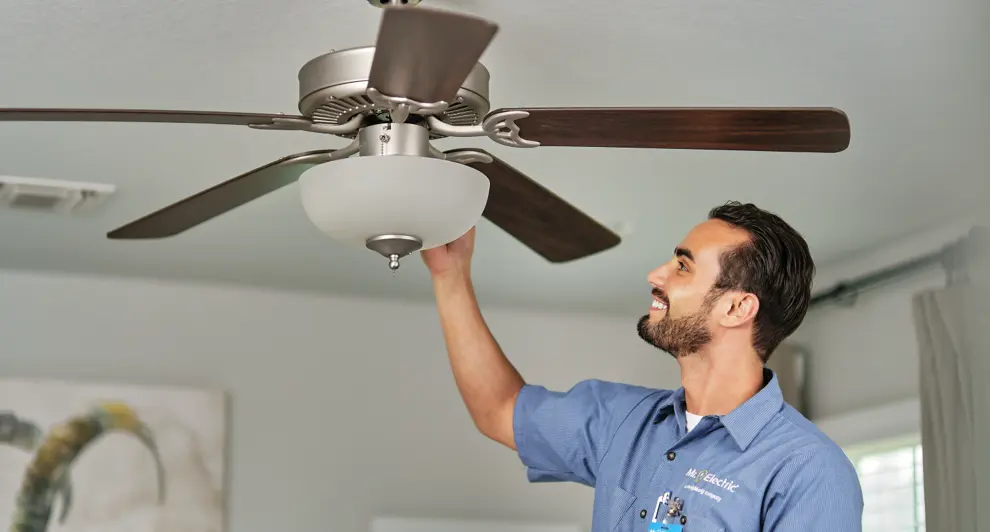
Mr. Electric explains how to install a ceiling fan without existing wiring or a fixture.
|
Whether they are circulating warm air during the winter or helping you cool down your space in the summer, there are many benefits to installing a ceiling fan in your home or office. Ceiling fans can even help you save money on your energy costs and stay comfortable during warmer seasons by reducing the need for air conditioning. But if there’s no existing wiring in place, installing a ceiling fan can feel like an insurmountable task.
In this article, we’ll walk you through how an electrician would install a ceiling fan in a room without existing wiring or a fixture — step by step, depending on your setup.
How to Install a Ceiling Fan Where No Wiring Exists
Since installing new wiring is involved in this process, we urge you to always hire a licensed electrician for ceiling fan installation where no wiring or fixture exists.
Below are the steps an electrician would take to install a ceiling fan.
1. Turn Off Electricity to the Circuit
The most important step in the whole process is the first: before doing anything else, turn off the power to the room where you’ll be installing the ceiling fan. Go to your circuit breaker box and switch off the breaker that controls the room. This will keep you safe from electrocution and make wiring the fan much easier. You should never, under any circumstances, perform electrical work on an active circuit.
2. Determine the Ceiling Fan Location
To maximize airflow, position the fan near the center of the room, making sure there’s enough space around it for the blades to rotate without hitting anything overhead. Use a tape measure to find the center, then grab a ladder and stud finder to locate one or two nearby ceiling joists. Mark the spot with a pencil.
Because ceiling fans can weigh 15 to 50 pounds, it’s essential to mount them to sturdy joists. Without proper support joists, the fan could become unstable, posing a safety hazard and risking damage to your ceiling, floor, or the fan itself.
3. Install the Electrical Box
Once you’ve chosen where the fan will go, the next step is to install an electrical box that can safely support it. As mentioned, ceiling fans can be heavy, so the box must be securely mounted to a ceiling joist or with a fan-rated brace. If your ceiling is already finished with drywall - as is common - you’ll be working through it to access the joists and install the box.
Start by marking and cutting a hole in the ceiling at the installation spot. How you will proceed will depend on whether the fan will be mounted to one joist or between two.
If Mounting to One Joist
- Trace the outline of the box (or use a template) onto the drywall.
- Push through a fan brace with the electrical box attached.
- Secure the brace to the support joists following the manufacturer’s instructions.
- Attach the box directly to the joist using nails or screws, following the manufacturer’s instructions.
If Mounting Between Two Joists
- Use a stud finder to locate and mark the positions of both joists.
- Measure and mark the center point between them.
- Trace the outline of the electrical box or use a template at this center point.
- Cut along the outline with a drywall saw to create the opening.
- Insert a fan brace with the electrical box attached into the ceiling through the opening.
- Secure the brace to both joists according to the manufacturer’s instructions.
- Slide the saddle over the brace to lock the box in place and prepare for wiring.
4. Run Wiring to the Fan
Choose or install the wall switch that will control the ceiling fan. Wiring will need to be run from the switch to the ceiling fan installation location. This can be done by using fish tape to pull the new wiring through the walls and up to where the new fan will be installed.
5. Mount the New Ceiling Fan
After the wiring is installed, the new ceiling fan will be assembled and mounted based on the manufacturer’s instructions. Turn the power to the circuit back on and test the fan to make sure it’s working properly.

Ceiling Fan Installation Services Near You
Installing a ceiling fan in a room with no existing fixture or wiring can be a difficult task. If you’re wondering how to install a ceiling fan without existing wiring, it’s important to work with an experienced electrician to ensure the job is done correctly and safely.
Your local Mr. Electric® is here to help with everything from ceiling fan installation to wiring updates, making the process much easier and more efficient. Plus, every job is backed by the Neighborly Done Right Promise® to ensure you’ll be happy with our work. Contact your local Mr. Electric service professional today for upfront pricing and expert installation that’s done right, safely, and efficiently.
This article is intended for general guidance only and is not applicable to every situation. You are responsible for determining the proper course of action for your property and situation. Mr. Electric is not responsible for any damages that occur as a result of advice and/or guidance derived from its blog content.
Some Mr. Electric services vary by location. Contact your local Mr. Electric franchise for more information.

